QuestionQUESTION: Hi Nicole,
I woke up this morning to find one of my two mollies (bought about 1.5 months ago) stuck on the water intake of my filter dead. I watch my fish closely on a daily basis and noticed absolutely no signs of disease, stress, or any problems. The night before it was active and happily nipping at algae on one of my Anubias plants.
Here are my aquarium details: 20 gallon, fully cycled, all levels tested correctly weekly. 5 red-eye tetras, 3 zebra danios, 4 silvertipped tetras, 2 black dalmation mollies (now 1). The red-eye tetras can sometimes be a little nippy/aggressive but they never bugged the mollies, only their own. I feed the fish a varied diet (flake, brine shrimp) once a day in the morning. I also do a 25-30% water change every 2 weeks. Tank temp is about 78-80 F. I have also not added any salt to my tank (I've heard that livebearers benefit from some aquarium salt but not necessary). I do not think the molly died of old age as it was a young, smaller molly when I purchased it about a month and a half ago. All fish seem very healthy, no signs of disease.
I inspected the dead fish and only noticed a white film on one side of its body. But I'm assuming it's just from being stuck on the filter intake after its death last night.
Have you ever experienced any sort of sudden fish death like this without any warnings or signs?? Any expert feedback would be greatly appreciated. Thanks!
ANSWER: Hi Julian,
Everything sounds fine, you seem like you take good care of your fishes, even providing them with some live plants which does wonders for water quality. I have theories as to why the molly died, but first a bit of background...
As you probably know, since you seem like you have researched already, mollies in particular, but livebearers in general, are known for being fussy about water quality. In particular, they require hard water to thrive. Acidic water is just not healthy for them. Incidentally, it is usually much more feasible to acclimate a soft water loving fish to hard water, but having a hard water loving fish in soft water never seems to work out. Alkalinity in particular is important, and depending on where you live in the country (and other factors such as whether you have well water, municipal water, etc.) you may not have much alkalinity reserve in your tap water. The only way to tell is to test it with a test kit. The higher the alkalinity, the better for mollies, as this keeps the pH stable - stability is the key to keeping fish healthy. Water with an "imperfect" pH that is sure and steady is much more suitable for keeping fish than a supposedly "ideal" pH that goes up and down. So if you ever add anything like pH up or down or any other product to make your water chemistry change, I would recommend you not do this. Don't make water changes with bottled water either, if you ever do. This also is something folks do with the intent of giving their fish "better" water, but in fact, this can be detrimental as bottled water is stripped of much of its carbonate hardness, along with the earth elements that both fish and plants need.
So, my first theory - and this may be incorrect - is that your pH experienced a dip down. It may not have been much, but enough to stress out the mollies who are sensitive to low carbonate hardness in their water. All fish tanks become acidic over time, so it is a fine idea to change water on a weekly basis, 30% sounds right. This is especially important for livebearers, since they thrive on fresh water, which prevents the undesirable acidification of your fish tank.
Another theory! Mollies are also sensitive to nitrogenous waste. Nitrates in particular seem to make them uncomfortable, high nitrates seem to be the reason for the neurological condition called "the shimmies" which seems to happen exclusively with mollies. Interestingly enough, in brackish water (fresh water with a percentage of marine salt mixed in) they become much more resilient and hardy and do not seem to mind some nitrates. However, when keeping mollies in fresh water, nitrates below 20 ppm are, in my experience, absolutely essential. Test kits will often indicate that nitrates twice this high are "safe" (and this is true for most freshwater fish, just not mollies) so just do your best to keep nitrates as close to 0 ppm as possible.
The last theory is that perhaps this was a male and female pair, and the molly that died was female, succumbing to stress from being in a stressful 1:1 male to female scenario. When keeping livebearers, a 1:3 male to female ratio is often recommended, so that the female livebearers will have the males' attentions spread out, so to speak, and no particular one will have to be courted relentlessly.
Do any of these theories sound plausible? Your fish load is basically fine, lots of active fish, and incidentally all of them favoring softer water. It is not uncommon to include livebearers in community tanks, but in my experience and opinion, livebearers do better in a tank of their own...or at least in a tank with other hard water loving fish such as x-ray or Pristella tetras, rainbowfish, etc... fish that are proven to like hard water and wouldn't mind the addition of some buffering agents such as crushed coral or oyster shell.
And, in response to your last question - have I ever experienced a sudden fish death, without any warning signs? - the answer is definitely yes, I have! However, after almost 7 years of being active in the hobby, I have come to learn a whole lot and find that almost every death has an explanation. So what may have been an unexplained death 3 years ago, would probably not be unexplained to me now!
The one thing you can do to guarantee a better chance of healthy, long-lived fishes, is to do more water changes! Up to 50% a week is fine, I would not do more as some nitrate is necessary to feed your plants. Remember that an aquarium is a closed system. The nitrogen cycle keeps your aquarium ammonia and nitrite free, but there will always be nitrates. While plants do their part by consuming nitrates, unless your tank is heavily planted and lightly stocked, any fish waste and uneaten food will almost always become metabolized into more nitrates than plants and filtration systems can handle. So, switch to weekly water changes, keep an eye on the pH, hardness and alkalinity of your aquarium water (especially this latter) and be sure to feed lightly, no more than twice a day. In fact, your diet could probably use a little variety. Brine shrimp is a real treat for the fish, but doesn't provide much nutritional value. Click on the link below for a list of alternative foods (fresh, frozen, and prepared) that you can feed to all of your fishes:
http://fish.mongabay.com/food.htm
Lastly, let me leave you with a few articles written by the brilliant Neale Monks. Real eye-openers!
http://www.wetwebmedia.com/FWSubWebIndex/mollies.htm
http://www.wetwebmedia.com/FWSubWebIndex/poeciliids.htm
http://www.wetwebmedia.com/FWSubWebIndex/fwhardness.htm
I hope that helps. Take care,
Nicole
---------- FOLLOW-UP ----------
QUESTION: Thank you Nicole! Great articles too! After reading your answer I have come to a few conclusions and follow ups.. The mollies were a peaceful female pair so the death was not caused by stress from a male. Also, my nitrates and nitrites are low so that wasn't it. However, based on your advice as well as the articles posted, I believe I have found the lethal causes. First - I have noticed the last few weeks or even month, actually, that the pH level of the tank is a constant 5-6, which is very low. It has consistently remained at this level so I am thinking the water here in southern CA has that pH. Secondly, my water routinely tests very low in Carbonate Hardness (KH), which I read is not good for mollies. General hardness is high though, but I guess it didn't help. I am pretty confident that a combination of these two issues caused the sudden fatality.
As you mentioned, I do have tetras and danios (soft-water fish) dominating the tank, with only one molly now. The reason I wanted some mollies is that I enjoyed their peaceful and almost gentle movements in the aquarium. My tetras and danios, while very beautiful, are very active fish that dart around from time to time. Do you have any recommendations of 'slower' types of fish that would thrive in my tank's water parameters (low pH, low KH). I agree with you in that I want to stay away from pH adjusters. I have looked at cherry and gold barbs before but I don't know enough about them at this time.
Thank you.
AnswerHi again, Julian!
I'm glad to have helped you find the cause of the sudden death. I am 99% positive that the lack of hardness (and probably also alkalinity) as well as the concurrent low pH, are indeed, the source of your troubles.
If the water straight out of your tap comes out this low - do test it to be sure - then it would be prudent to add some sort of buffer to your aquarium. Either the addition of some crushed coral (in a canister filter works best, but it can also be gently mixed in to the substrate) or oyster shell, perhaps even in a decorative style, incorporated into your aquascaping, would help. Another thing is limestone. This brings the pH up considerably, which is why African cichlid keepers use that kind of white rock called "Texas holey rock" so often in their aquariums! It brings the pH up.
I would also experiment with adding baking soda to your new water, the water you use for your water changes, that is. Unlike pH up powders, baking soda is inexpensive and mild. You can achieve consistent results, as long as you use it consistently. For example, if you are going to change 5 gallons of water per week, then you should add a teaspoon or two of baking soda and stir...this will buffer up the new water. How many teaspoons of baking soda to use, if you are interested, will be up to you to determine. Test the water and see if 2 teaspoons of baking soda per 5 gallons is too drastic a change in water chemistry. I would at least consider adding 1 teaspoon per 5 gallons of new water.
As for slower fish that do not need hard water, the cherry barbs would be fine, but will not school, as they are loners, mostly. At times they will hang out in loose pairs, but the shoaling effect will not be there. I've also noticed that females around here seem to be swollen in what I consider to be an alarming way in the store - not sure if they are full of eggs, or showing bloat or constipation. Gold barbs are gentle and hardy, but I wouldn't consider them slow...except compared to danios, those roadrunners!
So, the choice is yours. If you are looking for golden fish, the barbs will do just fine, but lemon tetras are among my favorites. Their subtle, at times faded, coloration in the store can be much enhanced at home with the use of color enhancing foods and a varied diet, along with the usual good husbandry. They also stay lean, whereas the barbs have a rather chunky tendency...maybe just from being such eager eaters! The Wikipedia entry below has a picture of a lemon tetra, which looks to be a well conditioned specimen:
http://en.wikipedia.org/wiki/Lemon_tetra
I have an elderly pair in my aquarium, and they still have terrific color. Once in a while they still seem to exhibit spawning behavior, bumping and rubbing into each other! I have to say, I am rather biased towards these little guys, but in my opinion they are one of the nicest tetras, and I have been very successful with keeping an almost exclusively tetra community tank, so I encourage others to do the same, since tetras seem to get along with each other so well.
The exception in my tetra tank, is the two female gold rams and one male blue ram who are also in there. These are another of my favorites, and indeed are rather slow moving, and appreciate acid water, but they need very warm temperatures to thrive - in the 80-82F range. Depending on the store, they also seem to be very delicate, particularly sensitive to shipping stress. If you are interested in a more challenging fish, I say go ahead and try blue or gold rams! A hardier ram to start with, however, would be a Bolivian ram. While not exactly as colorful, they are still perfectly vibrant fish, and a pair or a trio is delightful.
There's lots of information available online about Bolivian rams, you need only to Google Mikrogeophagus altispinosus for more information. Good luck, and happy fishkeeping!
Nicole
P.S. I'm glad you enjoyed the articles! I've become a diehard addict of wetwebmedia.com, checking their daily FAQs ...daily!

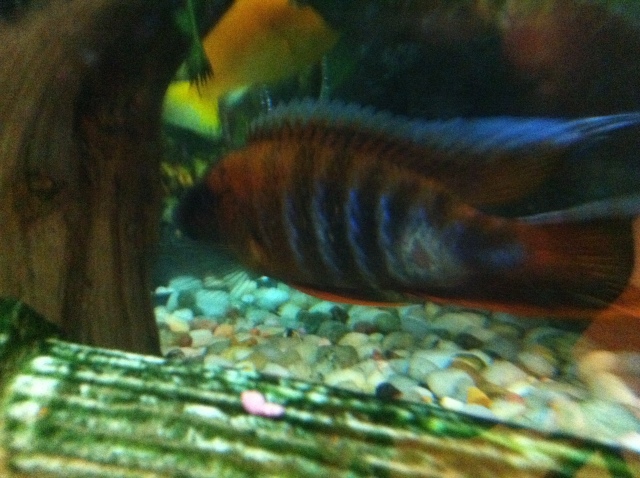 Sick cichlids! i dont want to lose them
QuestionQUESTION: Hello Renee, first off, thank you for
Sick cichlids! i dont want to lose them
QuestionQUESTION: Hello Renee, first off, thank you for
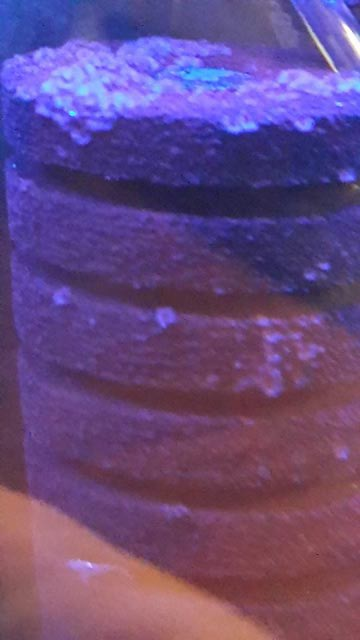 Pink fungus?
Question
pink fungus pink fungus
Hello,
I
Pink fungus?
Question
pink fungus pink fungus
Hello,
I
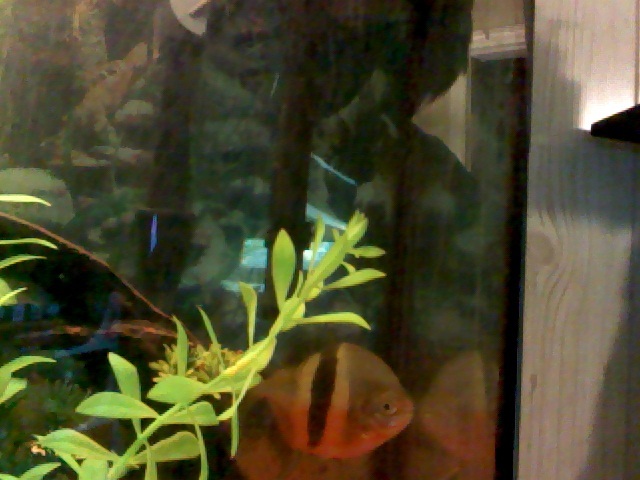 silver dollars
QuestionQUESTION: hello i have a 50 gallon fish tank an
silver dollars
QuestionQUESTION: hello i have a 50 gallon fish tank an
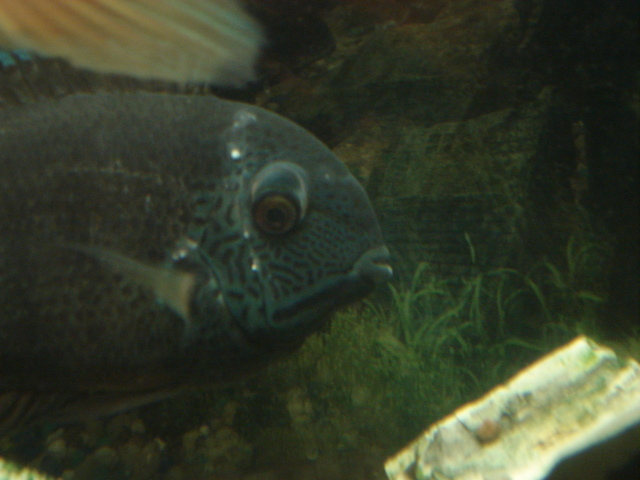 Sick Severum Cichlid
QuestionSick Severum
QUESTION: Hi, I hope you ca
Sick Severum Cichlid
QuestionSick Severum
QUESTION: Hi, I hope you ca
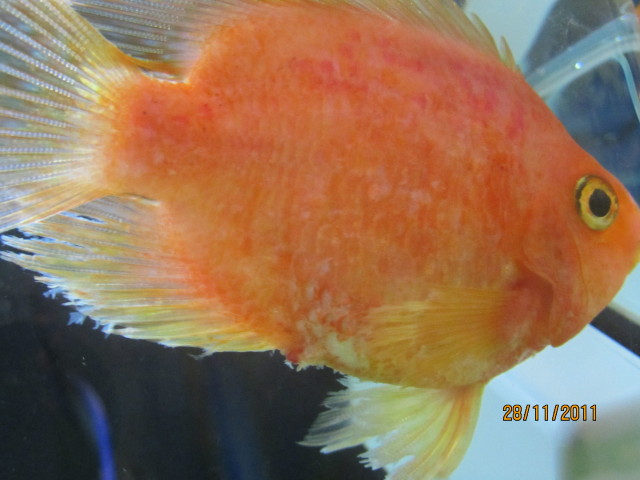 parrot fish disease
Question
parrot fish
i find out today the skin o
parrot fish disease
Question
parrot fish
i find out today the skin o